How To Multi Screen Windows 10

Whether you're content creator, programmer, data analyst, gamer, or someone who'due south recently been forced to piece of work from home, a system with multiple monitors not simply looks peachy, but it can significantly improve productivity when multitasking with several apps. However, a multi-monitor setup is only practical as long as you configure it correctly.
Windows 10 has several features and settings to back up 1, 2, three, 4, and even more than monitors without the need for third-political party software for the best experience.
In this Windows x guide, we'll walk you lot through a bunch of tips to configure and use a multi-monitor setup, whether you lot're connecting an external display to your laptop, or you're connecting 2, 3, or more monitors to your workstation.
- Earlier configuring a multi-monitor setup
- How to rearrange multiple displays on Windows 10
- How to adjust displays scale and layout on Windows ten
- How to select multiple displays viewing manner on Windows 10
- How to manage avant-garde display settings on Windows ten
- How to evidence taskbar across multiple displays on Windows 10
- How to modify background on multiple displays on Windows ten
Before configuring a multi-monitor setup
Before configuring multiple monitors on your device, make sure that all the necessary cables are continued to the monitors and the figurer. This includes connecting power and video signal using VGA, DVI, HDMI, or DisplayPort (recommended) cables.
If you're not sure, confirm the make and model of the monitor (usually from a sticker in the back), and search online for the manufacturer manual to get a improve idea on how to connect the display.
How to rearrange multiple displays on Windows 10
While you lot tin connect a monitor to any available video ports on the graphics card, when setting up a dual-monitor or triple-monitor setup, it'southward easy to plug them in the incorrect order. Although they will even so work, you lot may run into issues using the mouse and running applications until you rearrange them correctly.
To rearrange monitors on Windows 10, use these steps:
- Open Settings.
- Click on Arrangement.
- Click on Display.
- Under the "Select and rearrange displays" department, drag and drop each brandish to rearrange them according to their concrete layout on your desktop.Quick tip: When rearranging monitors in the "Brandish" settings folio, make sure that all monitors align at the top perfectly. Otherwise, you'll have problems moving the mouse cursor betwixt monitors from the corners.

- Click the Apply push.
Once you lot complete the steps, Windows 10 will save the physical layout, and you'll be able to work beyond each display and run apps without problems.
If you lot're not sure which monitor you're selecting, click the Place push to figure out. If ane of the monitors isn't showing up, brand sure it'south receiving power and connected correctly, and click the Find push. In the case that y'all're still having problems, reset their connections (or restart the computer), and try the Detect push button again.
How to conform displays calibration and layout on Windows ten
When connecting ane or multiple displays to a computer, Windows 10 does a pretty adept job detecting and configuring the most optimal settings. Yet, depending on your requirements, yous may demand to adjust scaling, resolution, and orientation for each monitor.
Selecting correct scale
Windows 10 includes settings to adjust the scaling, which are useful when setting up various monitors of different sizes and screen resolutions to make text, apps, and other items look the same size across the displays. Or, if you accept a 4K brandish, for instance, adjusting the calibration settings can help to make items bigger and more than readable.
To select the correct scale setting that suits your requirements, use these steps:
- Open Settings.
- Click on Organization.
- Click on Display.
- Under the "Select and rearrange displays" department, select the monitor that you want to suit.
- Use the Change the size of text, apps, and other items drop-downwards menu to select the appropriate scale option.
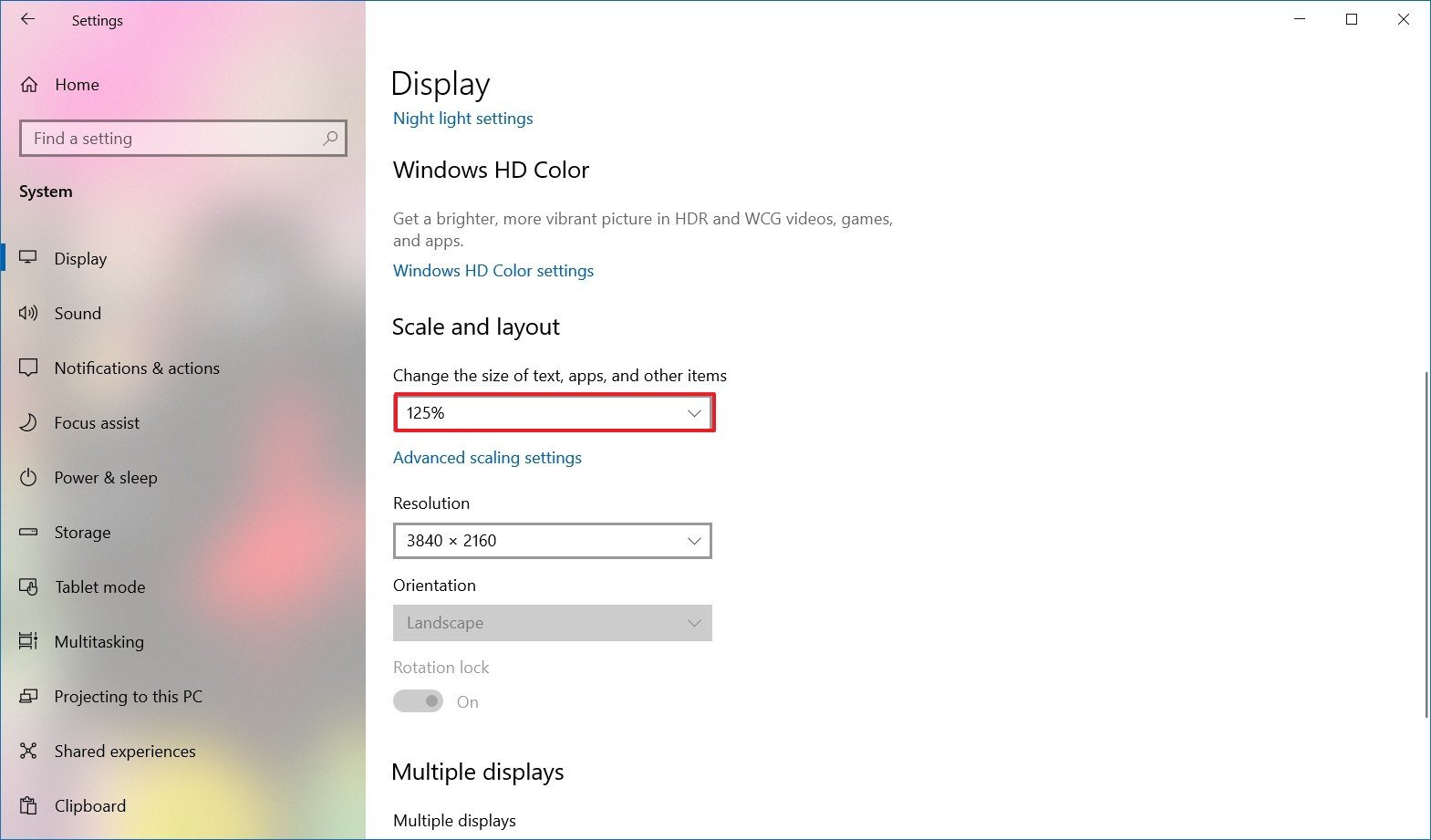
Afterward y'all consummate the steps, you may demand to echo steps No. 4 and five to alter the scaling settings on the other monitors, so click the Sign-out option to apply the changes.
While you tin can arrange the scaling settings on a per-monitor basis, when possible, it'southward always best to utilize the same make and model of the monitors with the same configuration. Otherwise, y'all may meet issues, and Windows 10 may accept problems scaling elements.
If you lot're in the market place for a second monitor to aggrandize your laptop or desktop sheet, nosotros recommend the Dell UltraSharp U2719D considering of its accurate color reproduction, size, slim vessel design, VESA mount compatibility, and value.
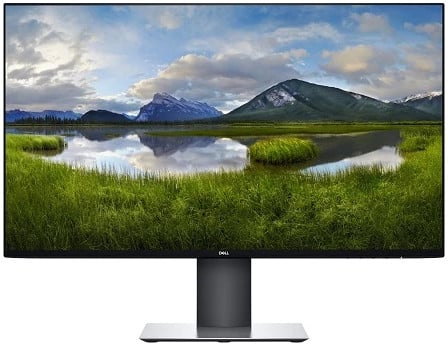
Dell UltraSharp U2719D
A new monitor with everything you need
Dell builds great quality monitors, and the U2719D is a good instance. Information technology has everything you need, including DisplayPort and HDMI, VESA support, 27-inch IPS panel with a resolution of 2560x1440 pixels for anything yous want to be done.
Custom scaling
To specify a custom scaling value, utilise these steps:
- Open Settings.
- Click on Arrangement.
- Click on Display.
- Nether the "Select and rearrange displays" section, select the monitor that you want to adjust.
- Under the "Scale and layout" section, click the Advanced scaling settings option.
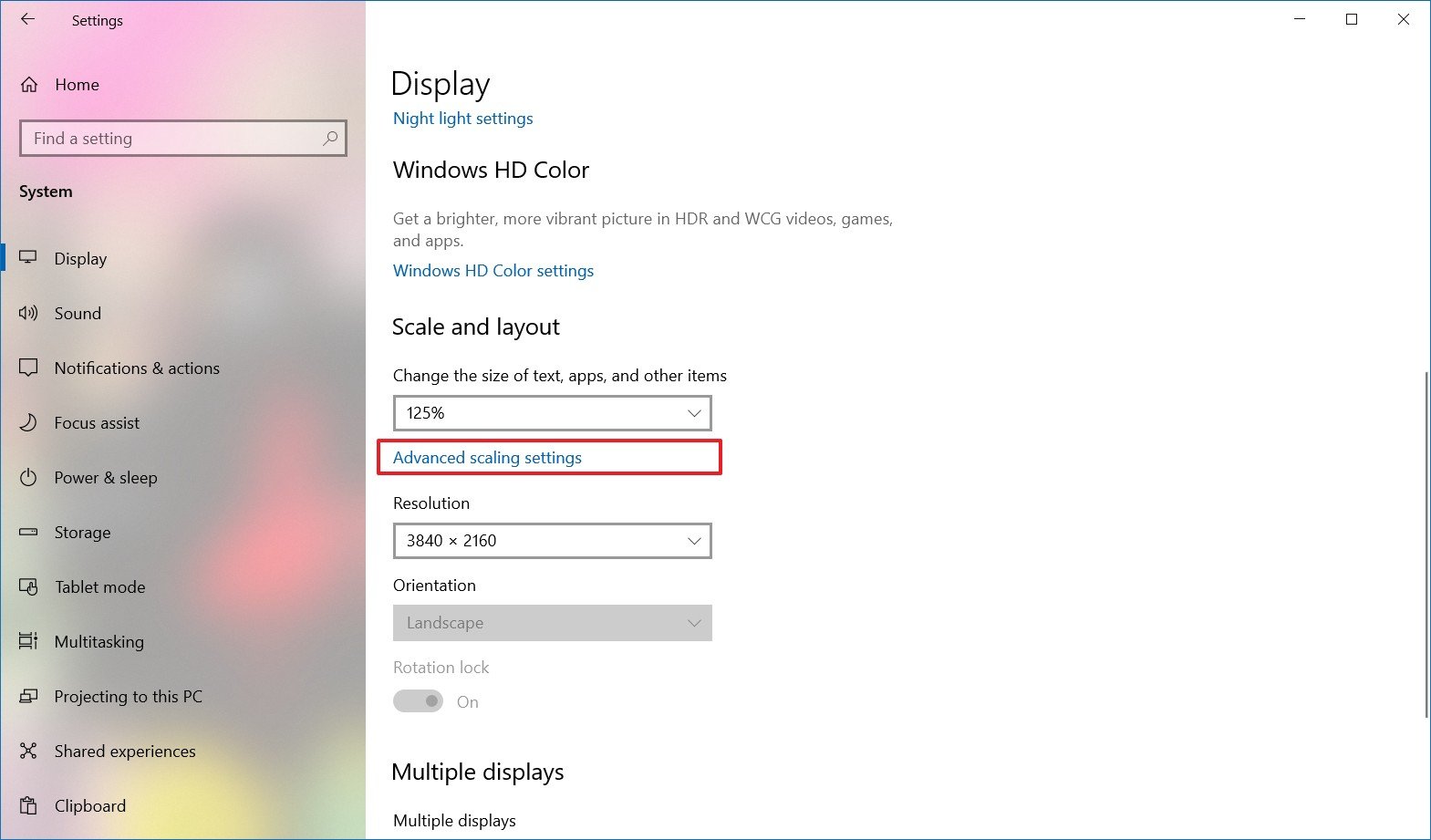
- Under the "Custom scaling" section, specify the scaling size between 100 and 500 percent.
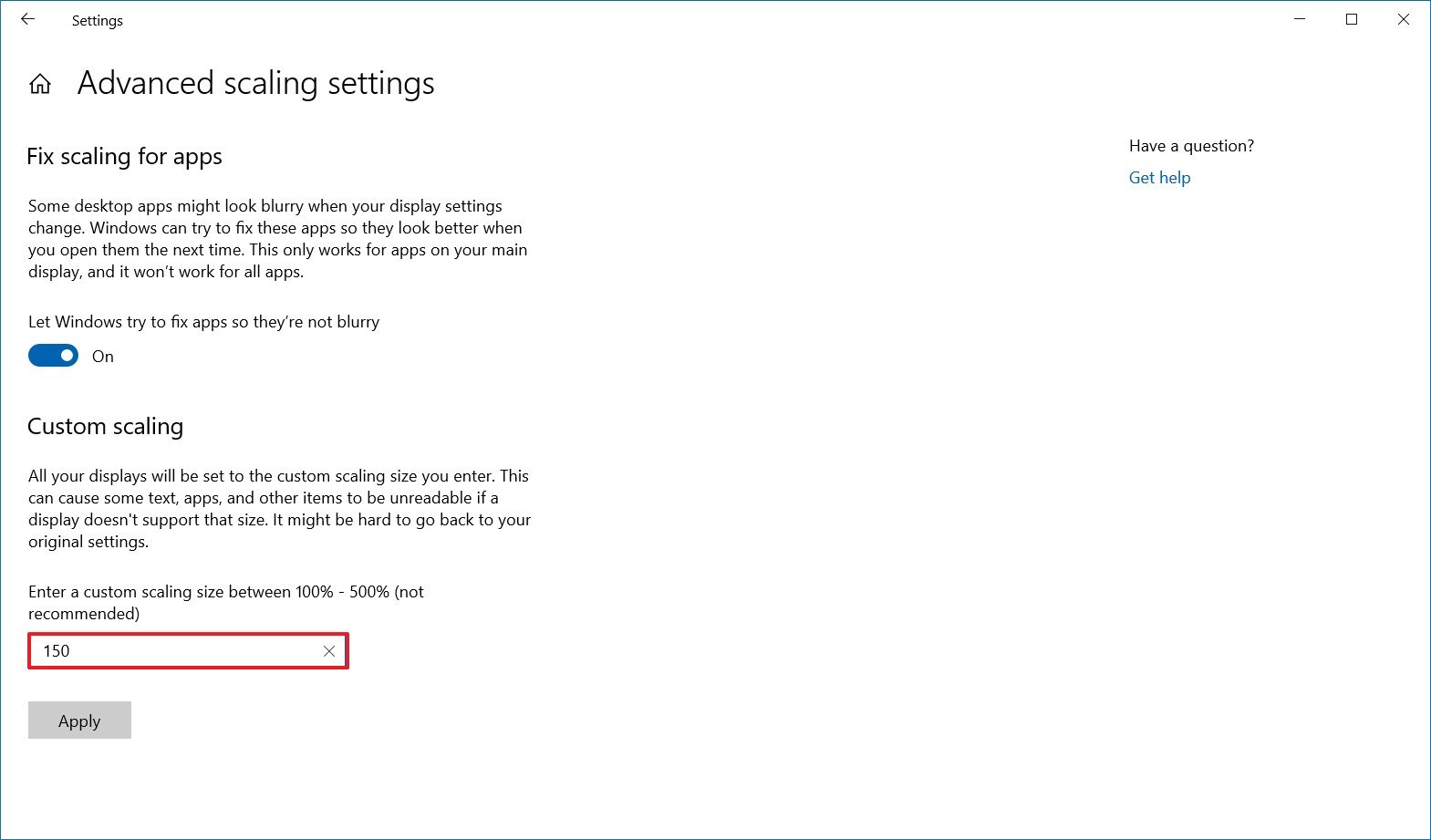
- Click the Apply button.
After y'all consummate the steps, sign out of your account and sign dorsum in to test the new settings. If the new scaling configuration doesn't wait correct, use the same steps again and try a unlike value until you notice a comfy setting.
If you want to switch to the predefined scale settings, you must first turn off custom scaling and sign out. Otherwise, the option will be grayed out.
Selecting correct resolution
Usually, after connecting a monitor, Windows x will gear up the recommended pixel resolution automatically, merely yous can likewise alter the resolution manually with these steps:
- Open Settings.
- Click on System.
- Click on Display.
- Nether the "Select and rearrange displays" department, select the monitor that you want to adjust.
- Under the "Scale and layout" section, employ the Resolution drop-downwardly bill of fare to select the correct pixel resolution.
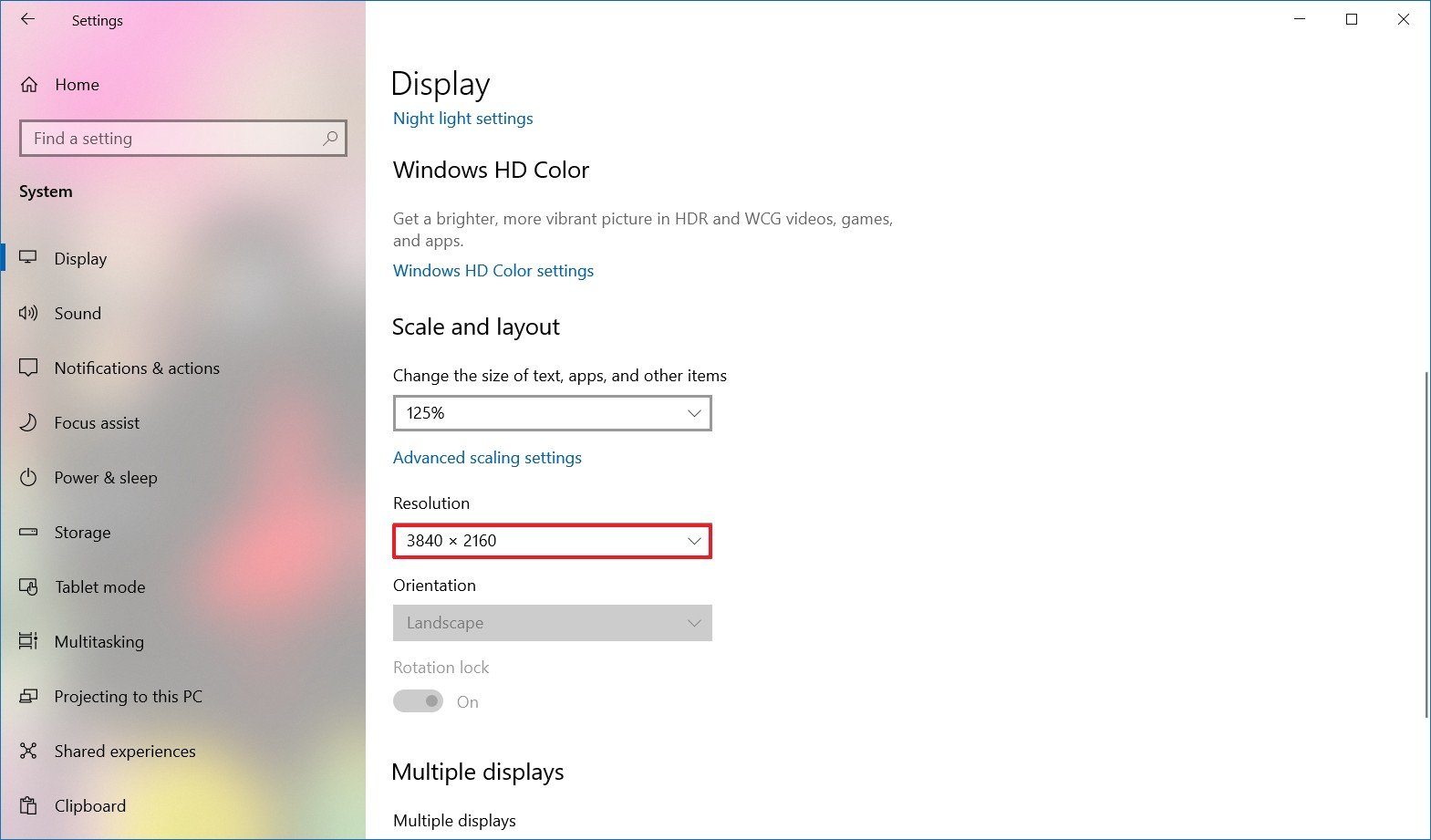
In one case you consummate the steps, repeat steps No. 4 and 5 to modify the resolution on the remaining monitors.
If yous're looking to brand text and other items bigger on the screen, you should be changing the scaling settings, not the display resolution.
Selecting right orientation
Windows x likewise allows you to rotate the screen horizontally or vertically, which is particularly useful when you have monitors with stands that rotate, and you desire to utilise them with a dissimilar orientation for reading or coding.
To change the orientation per-monitor, use these steps:
- Open Settings.
- Click on Organisation.
- Click on Display.
- Nether the "Select and rearrange displays" department, select the monitor that you desire to arrange.
- Under the "Scale and layout" section, utilize the Orientation drop-down bill of fare to select the fashion:
- Mural.
- Portrait.
- Landscape (flipped).
- Portrait (flipped).
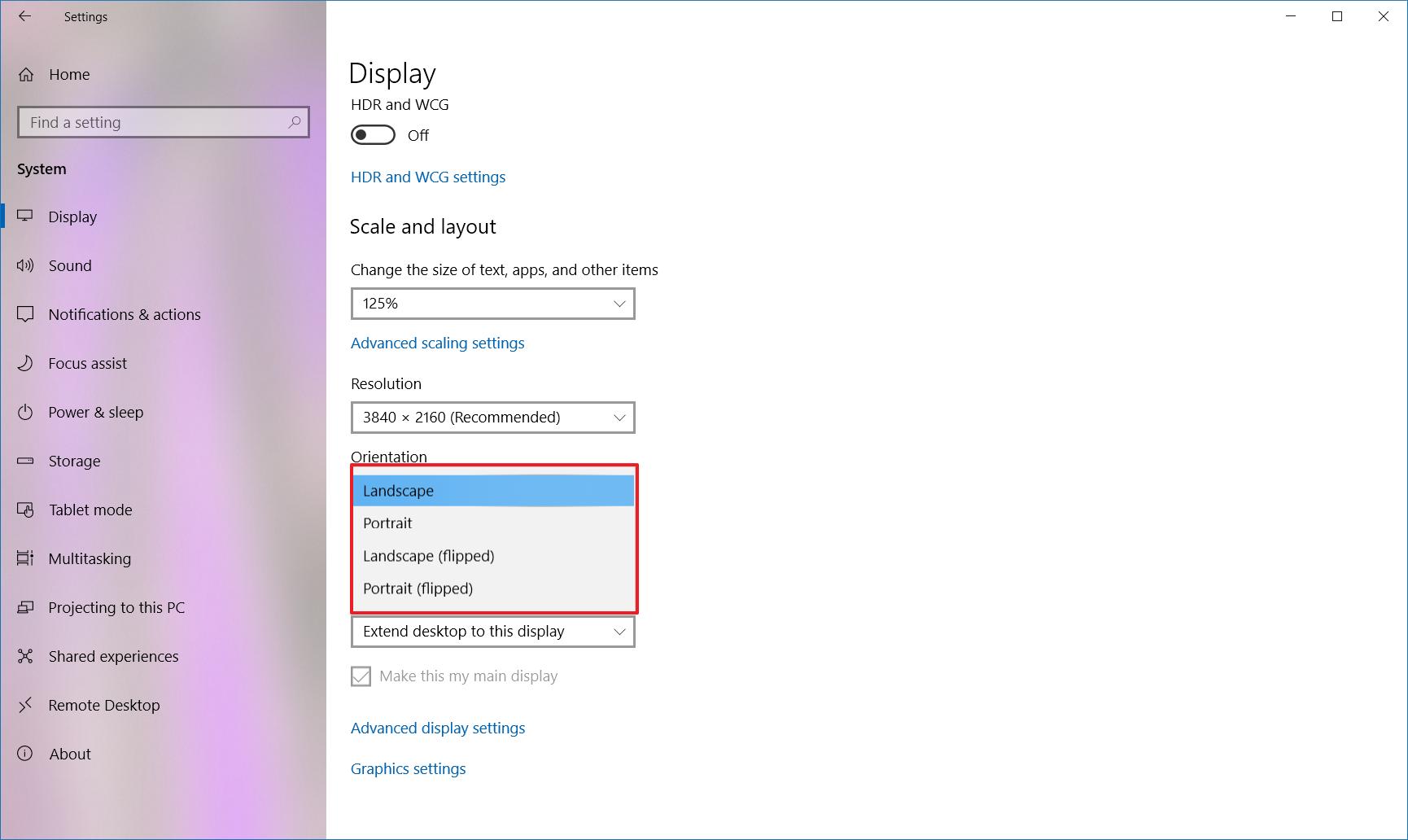
Once you complete the steps, the display will shift to the orientation you selected.
How to select multiple displays viewing mode on Windows 10
Using the available settings, y'all tin also choose the viewing style for your displays. For example, if you lot're using a second monitor, y'all can expand the master screen to the new display, or you can mirror both monitors, which is an ideal option when showing a presentation. If yous're using a laptop with an external monitor, you lot tin can even disable the master brandish, and only utilize the second monitor as your chief.
To change the viewing mode on Windows 10, utilize these steps:
- Open up Settings.
- Click on System.
- Click on Display.
- Under the "Select and rearrange displays" section, select the monitor that y'all want to accommodate.
- Under the "Multiple displays" section, use the drop-down bill of fare to set the appropriate viewing mode:
- Duplicate desktop — Shows the same desktop on both displays.
- Extend — Expands the principal desktop to the secondary display.
- Disconnect this brandish — Plough off the selected monitor.
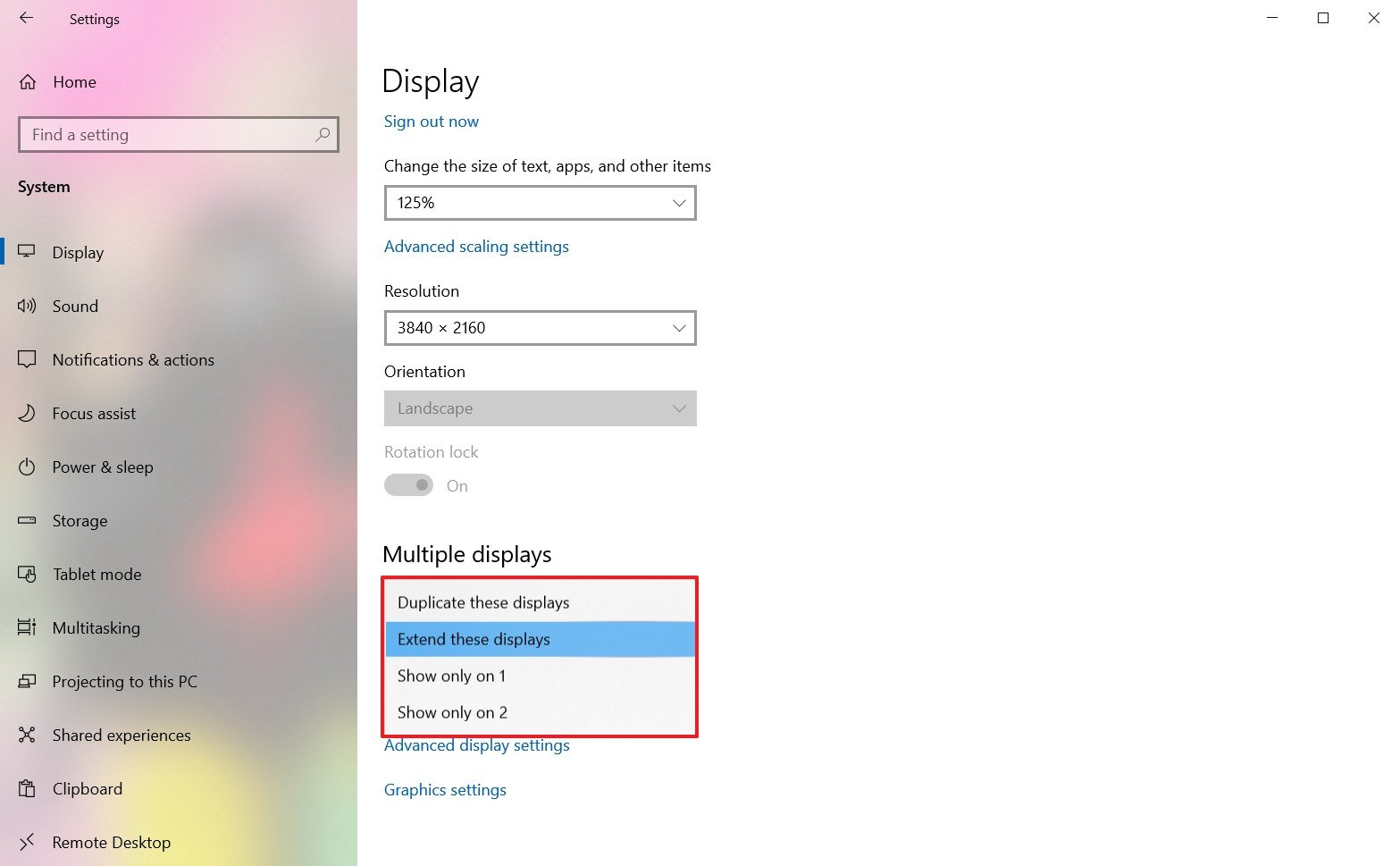
After y'all complete the steps, you may demand to repeat steps No. iv and 5 to set the display mode on the remaining monitors. Also, note that using these settings, you can make any of the monitors every bit your primary display.
Switching brandish modes with shortcut
In addition to using the Settings app, Windows 10 also allows you to switch display modes on the fly using the Project feature, which y'all tin can admission using the Windows key + P keyboard shortcut.
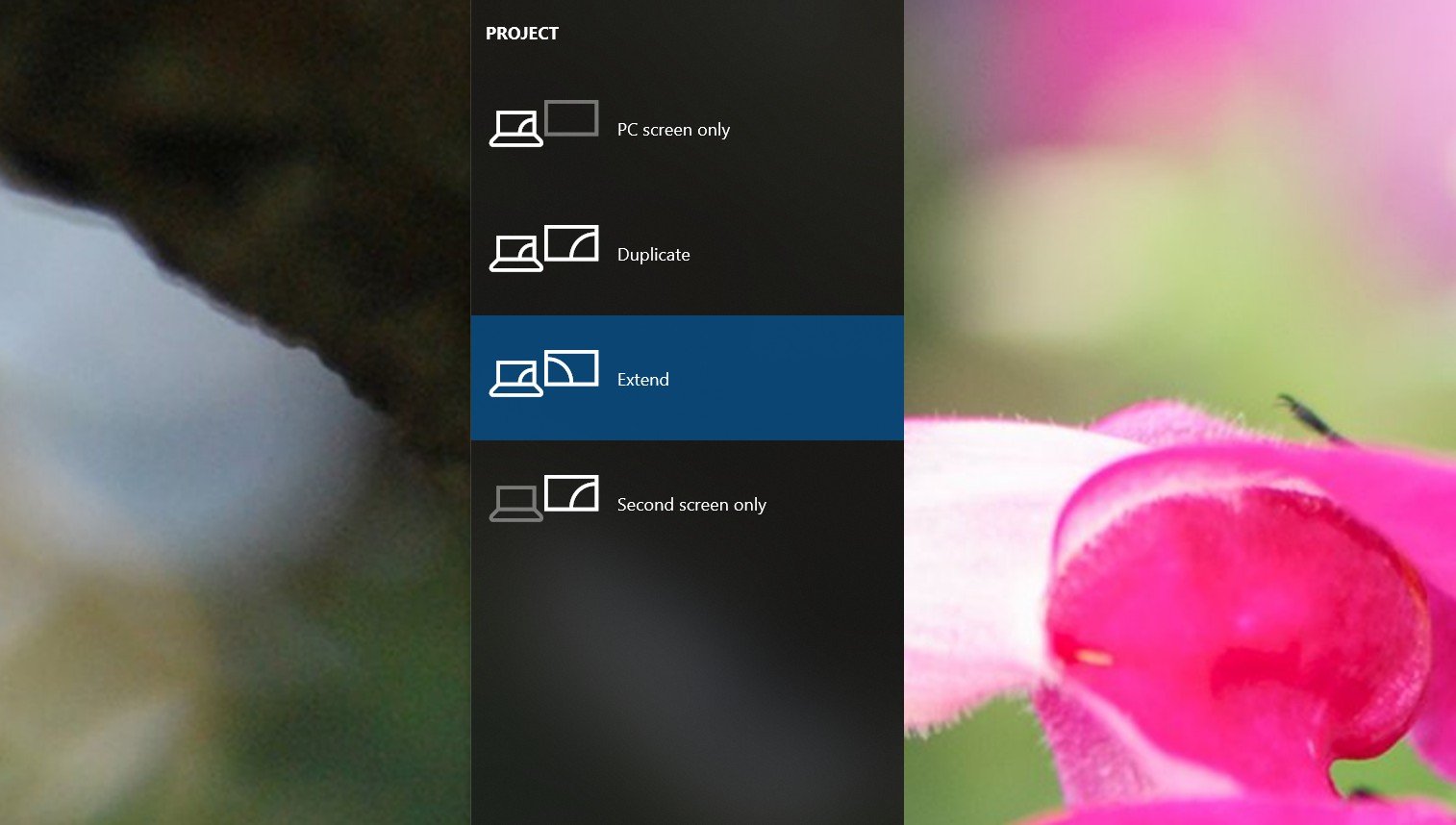
In one case you invoke the shortcut, a flyout volition open up from the right side with four options, including:
- PC screen only — Only the chief brandish is used.
- Indistinguishable — Secondary displays will mirror the primary monitor.
- Extend — Both screens are combined to offering an extended desktop.
- Second screen simply — Just the secondary displays is used.
Typically, when using a multi-monitor setup on a desktop or laptop, you want to use the "Extend" selection. This allows you to utilize the master monitor normally and the secondary monitors at their native resolution creating a single large canvas.
Indistinguishable is a good selection when using a second monitor or projector to show a presentation. In contrast, the 2d screen just option is cracking when yous want to close the lid on a laptop and work only with the external monitor.
How to manage avant-garde display settings on Windows 10
Although information technology'due south non e'er recommended to modify your avant-garde display settings, because not all monitors are created equal, sometimes, yous may demand to brand a few adjustments to improve color accuracy and remove screen flickering.
Important: Nosotros merely recommend adjusting the advanced settings if you have a crude thought of what to practise. Typically, yous should be fine with the default display settings.
Setting a custom color profile
If your monitors aren't rendering the colors accurately, yous can employ a custom color contour to meliorate color accuracy using these steps:
- Open Settings.
- Click on System.
- Click on Display.
- Click the Avant-garde brandish settings option.
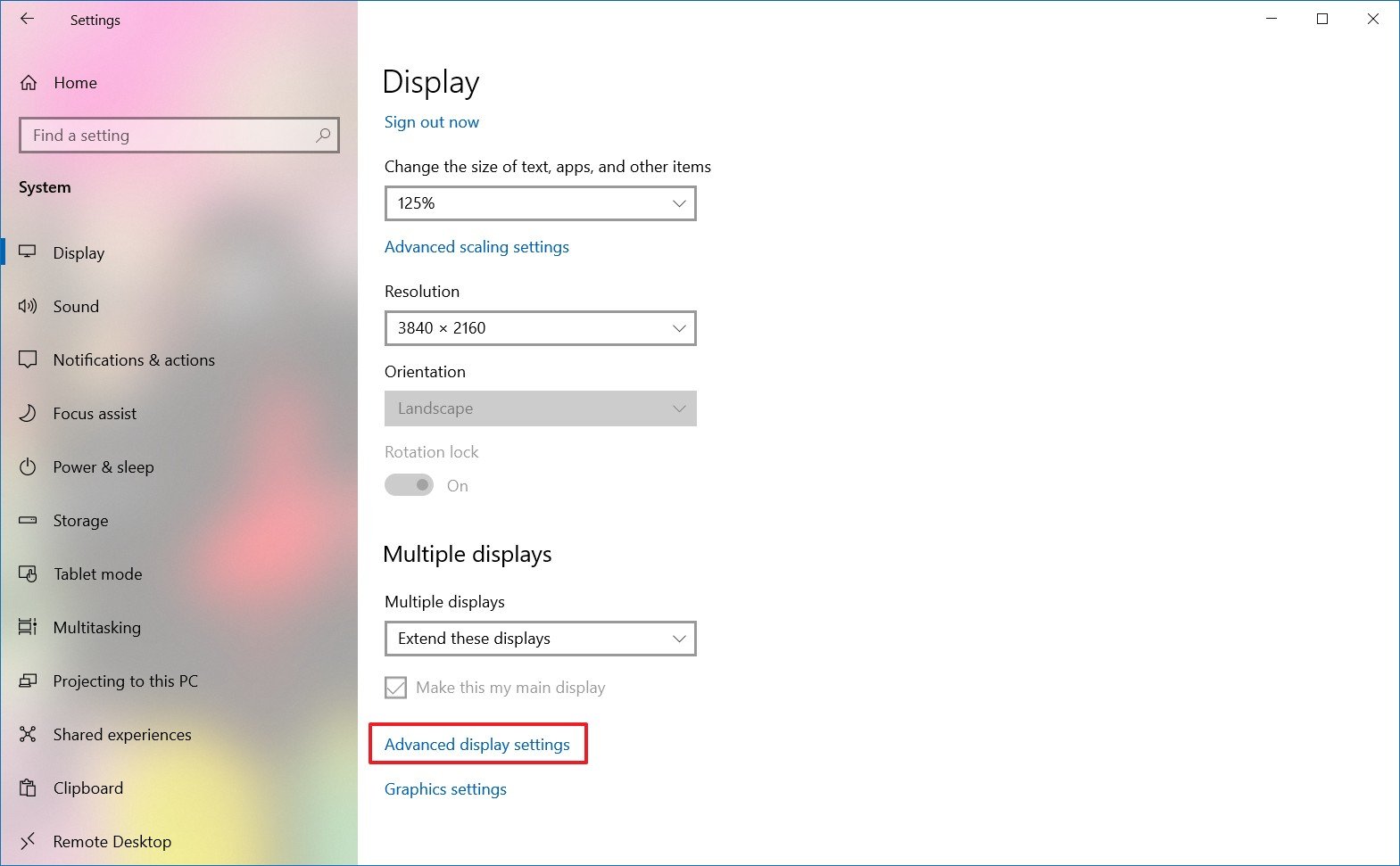
- Click the Brandish adapter properties selection for the display that you want to set a custom color profile.
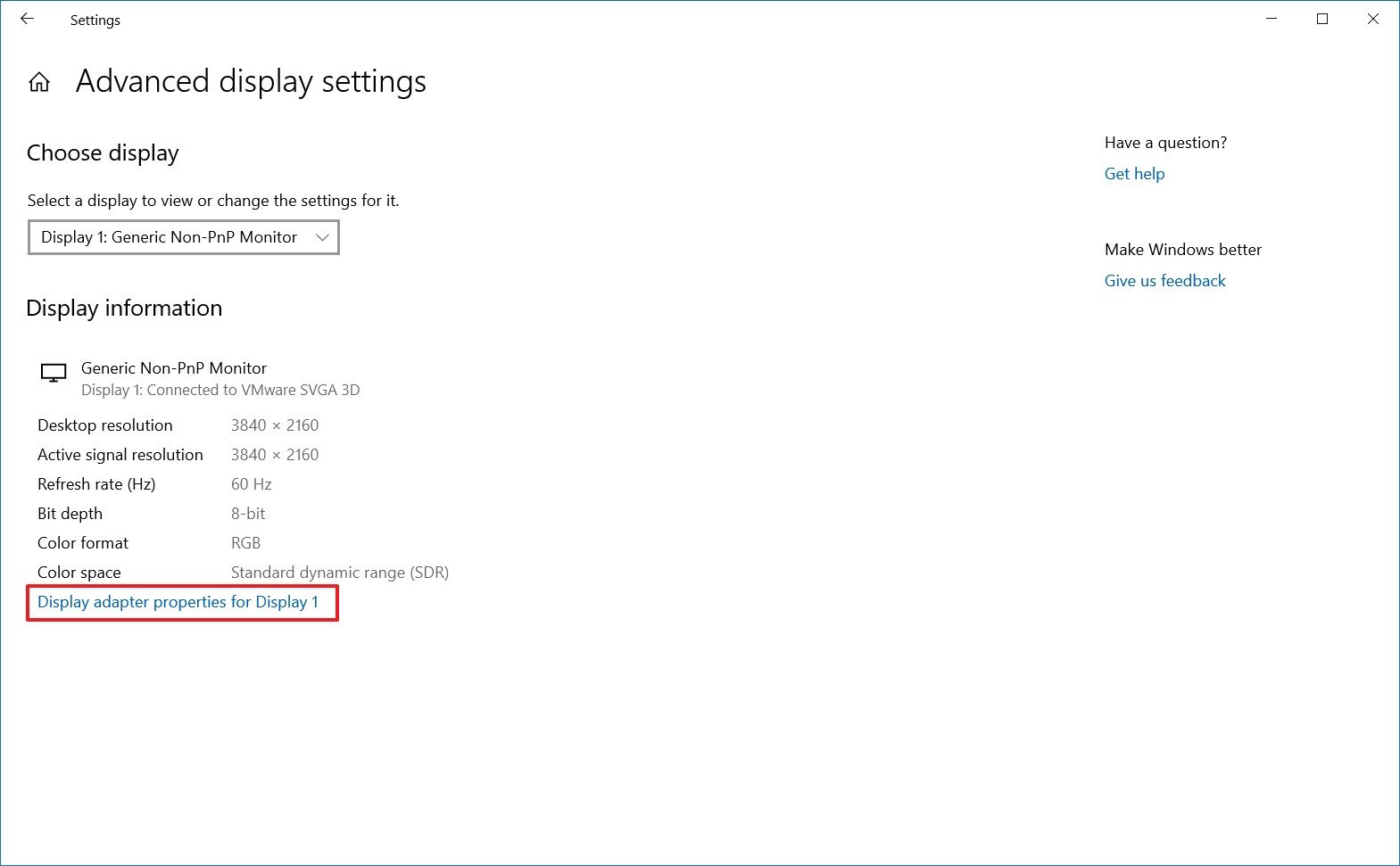
- Click the Color Direction tab.
- Click the Colour Management push.
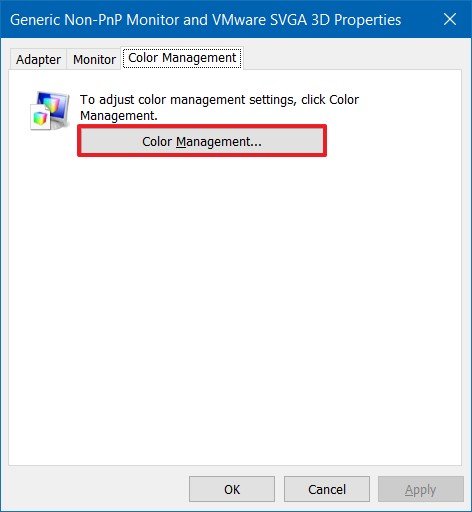
- Click the Devices tab.
- Select a display from the list.
- Bank check the Use my settings for this display option.
- Click the Add button.
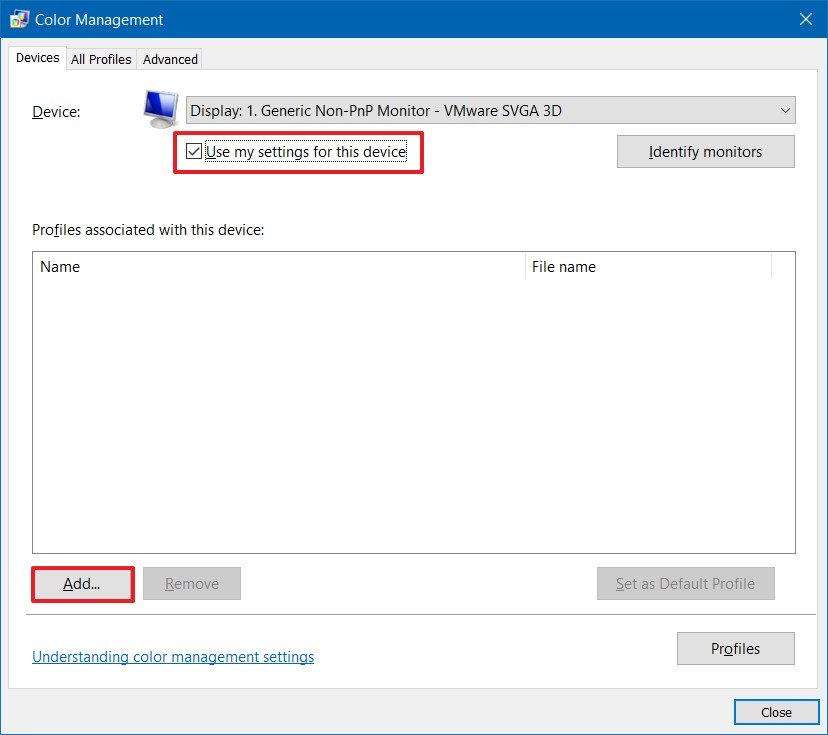
- On the "Associate Color Profile" page, click the Scan button and locate the new color profile.
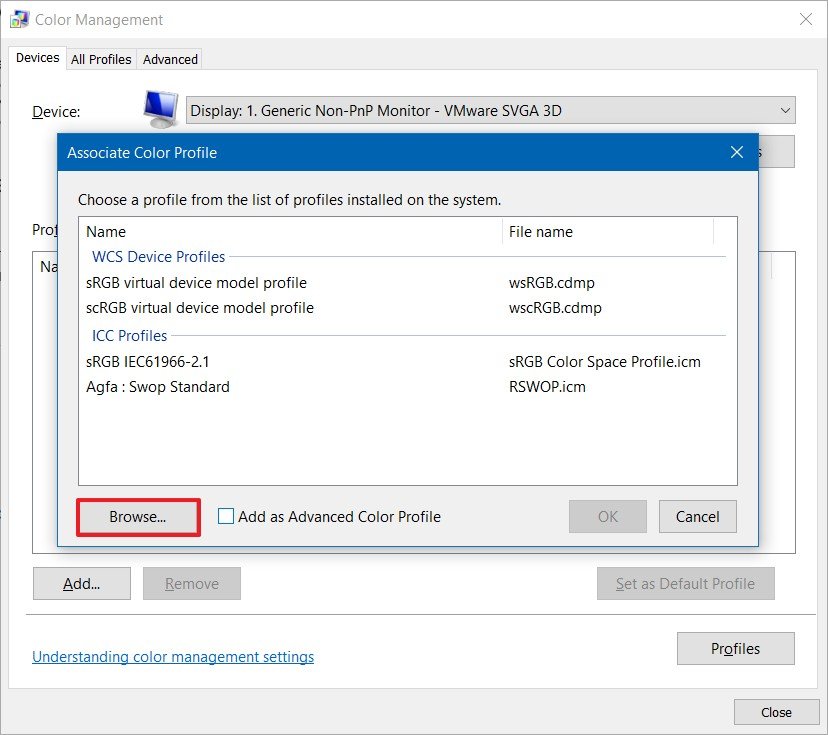
- Double-click the .icm file to install the new profile.
- Click the Close button.
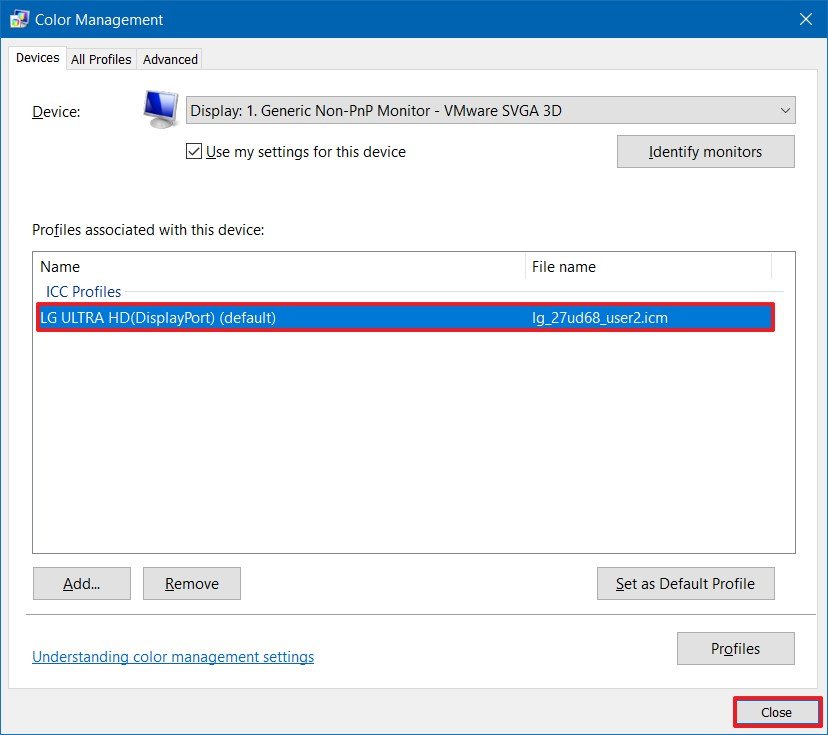
Once you complete the steps, y'all may need to echo steps No. 9 through thirteen to ready a custom profile for the other monitors.
When configuring a custom color profile, you should use those created by your brandish manufacturer or from a trusted source. If y'all're not certain, you can use these steps to download the correct color contour for your monitors.
Changing the refresh rate
Usually, a refresh rate (frames per second) of 59Hz or 60Hz is more than enough to operate a computer, though you'll definitely desire to look at the all-time monitors for Xbox Serial X and Serial Due south if yous plan to game at college framerates. However, if you're noticing screen flickering, or if you accept monitors that back up a higher refresh rate, bumping the settings can provide a better and smoother viewing experience — especially for gamers.
To adjust the refresh charge per unit of a monitor, utilize these steps:
- Open Settings.
- Click on System.
- Click on Display.
- Click the Advanced display settings option.

- Click the Display adapter properties option for the display you desire to modify the refresh rate.

- Click the Monitor tab.
- Under the "Monitor Settings" section, use the drop-downwards menu to ready the correct refresh rate.
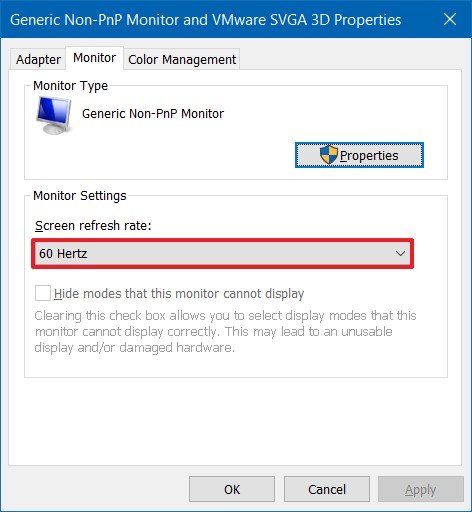
After you complete the steps, you may need to repeat steps No. 5, 6, and seven to change the refresh charge per unit on the remaining monitors.
How to show taskbar across multiple displays on Windows 10
On a multi-monitor setup, the taskbar by default will appear but in the principal display, but you tin change the settings to bear witness it beyond all the displays using these steps:
- Open Settings.
- Click on Personalization
- Click on Taskbar.
- Under the "Multiple display" department, turn on the Show taskbar on all displays toggle switch.
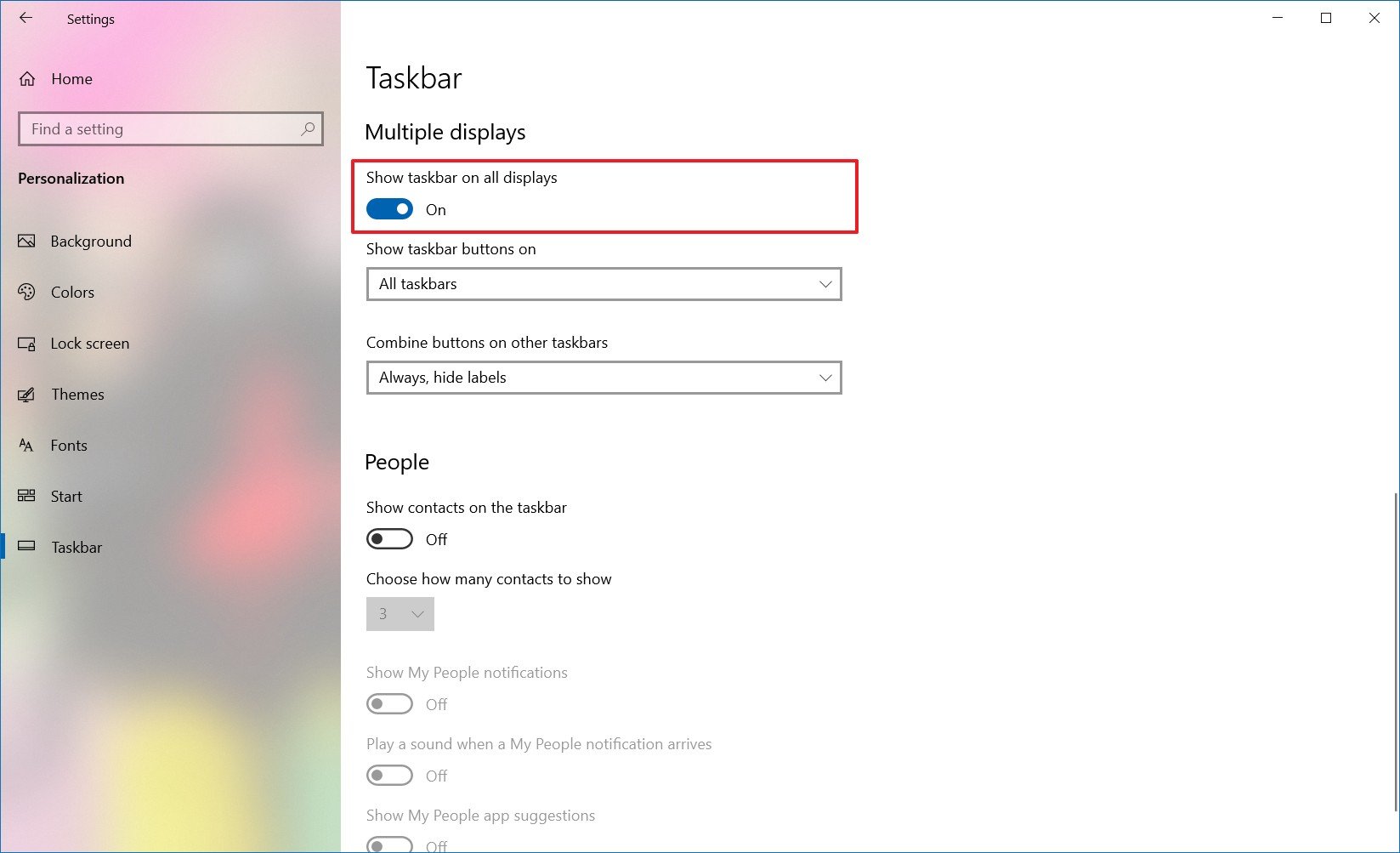
If you want to control in which taskbar the buttons for running apps should appear, then use the Show taskbar button on the drop-downwardly menu and select one of the bachelor options:
- All taskbars.
- Main taskbar and taskbar where window is open.
- Taskbar where window is open.
As well, you tin can use this guide to optimize the space on the taskbar to pivot even more apps or to keep it every bit minimal as possible.
How to alter background on multiple displays on Windows 10
Windows 10 offers a lot of settings to conform the look and feel of the desktop, simply when using multiple monitors, setting up different background images on each display is one the most significant customization that y'all can make to personalize your experience.
To show dissimilar wallpapers on a multi-monitor setup using a slideshow, employ these steps:
- Open Settings.
- Click on Personalization.
- Click on Background.
- Employ the "Background" drop-downward carte du jour and select the Slideshow pick.
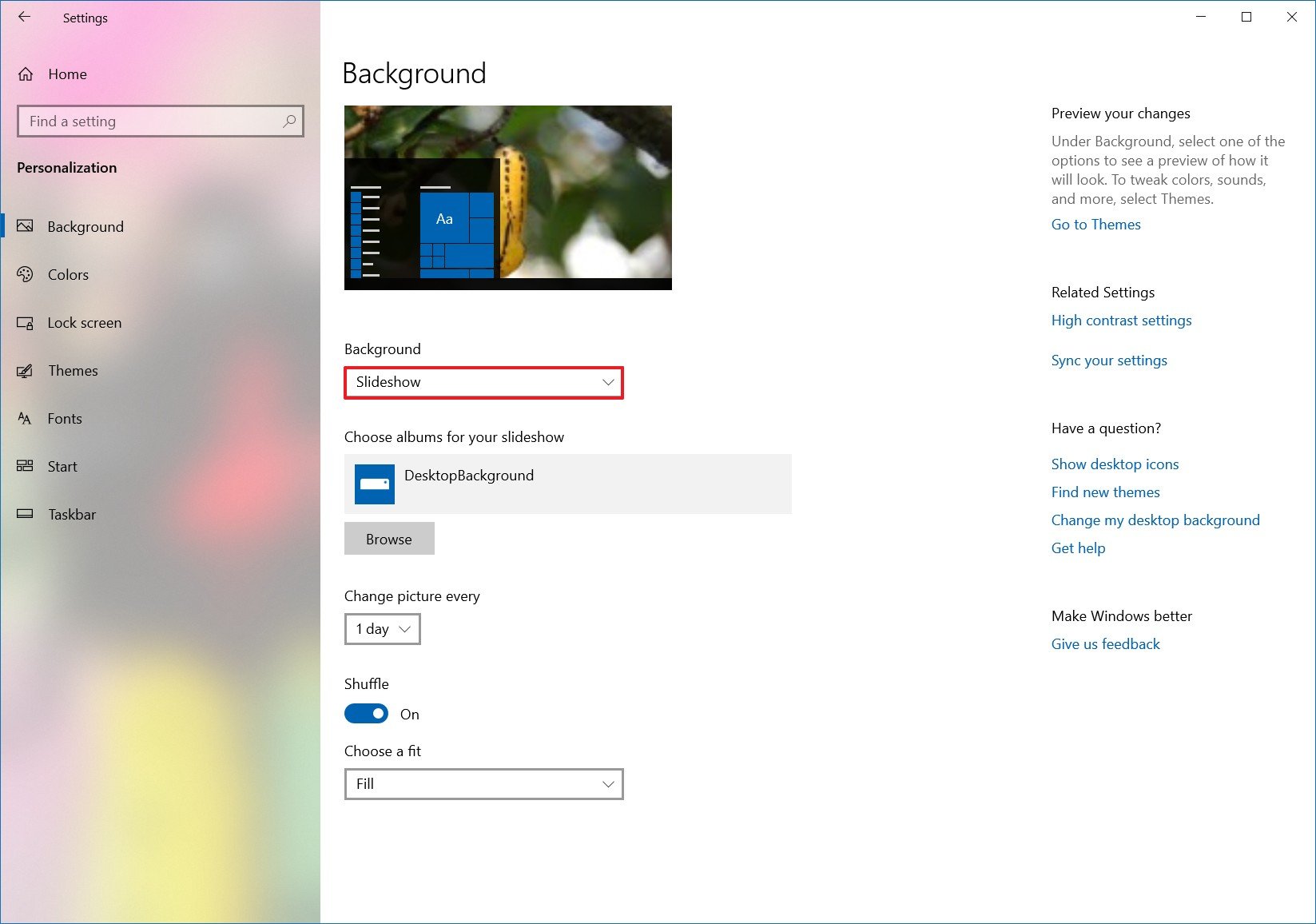
- Click the Browse button.
- Select a folder with a collection of images that you'd similar to display on the monitors.
- Click the Choose this folder button.
- Utilize the "Change movie every" drop-down carte du jour to select the rotation frequency.
- Plough on the Shuffle toggle switch.
- (Optional) If yous're using different sized images, employ the Choose a fit driblet-downwards card and select the Fill option.
Once you complete the steps, the images will rotate on the desktop background using the rotation frequency that you lot selected.
Customizing each monitor with a different groundwork
If you want to set a different background image for each monitor, apply these steps:
- Open Settings.
- Click on Personalization.
- Click on Groundwork.
- Use the "Background" drop-down card and select the Picture show option.
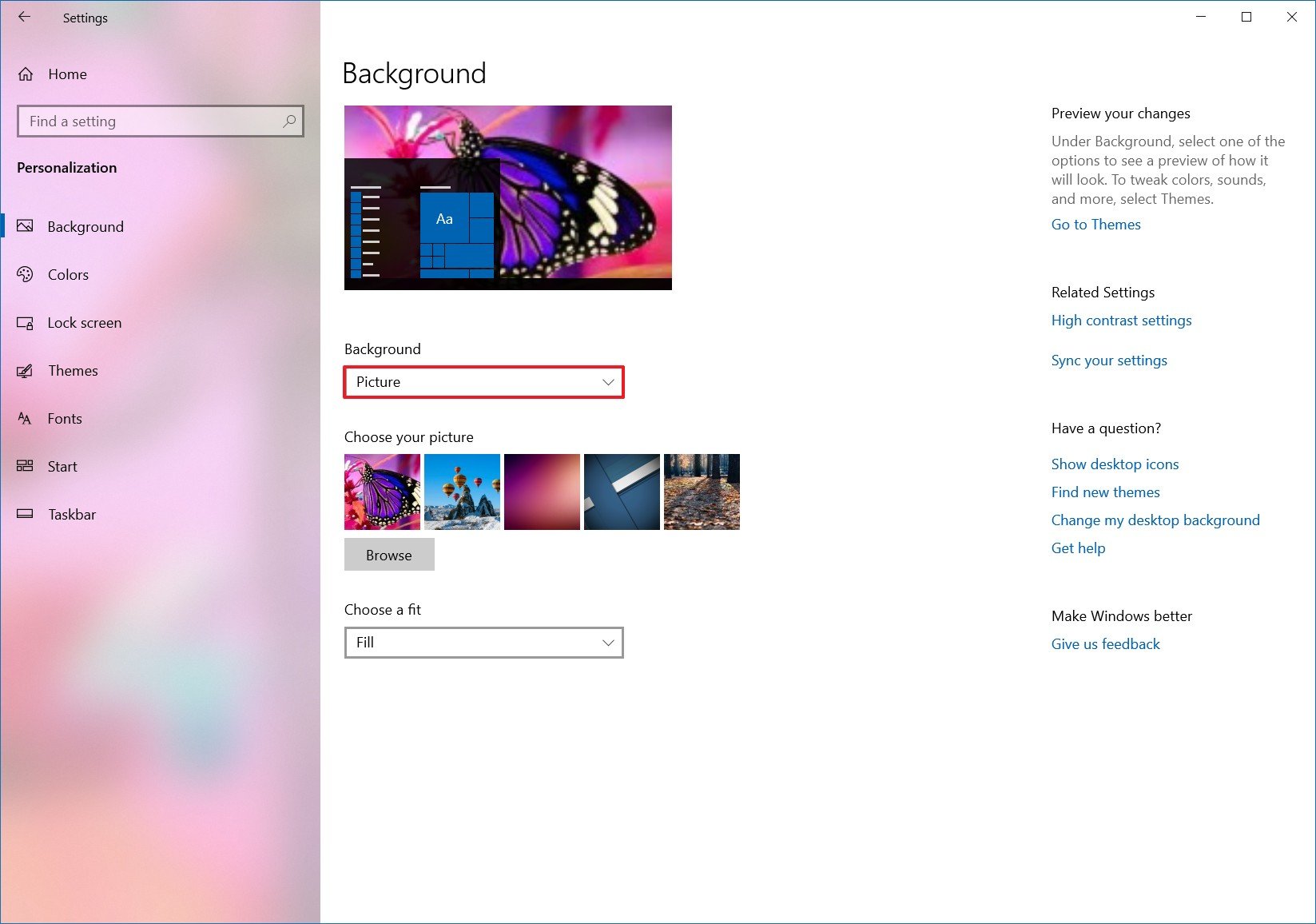
- Click the Browse push button.
- Select the wallpaper and click the Choose flick option.
- Correct-click the image and select the monitor you want the wallpaper to prove.
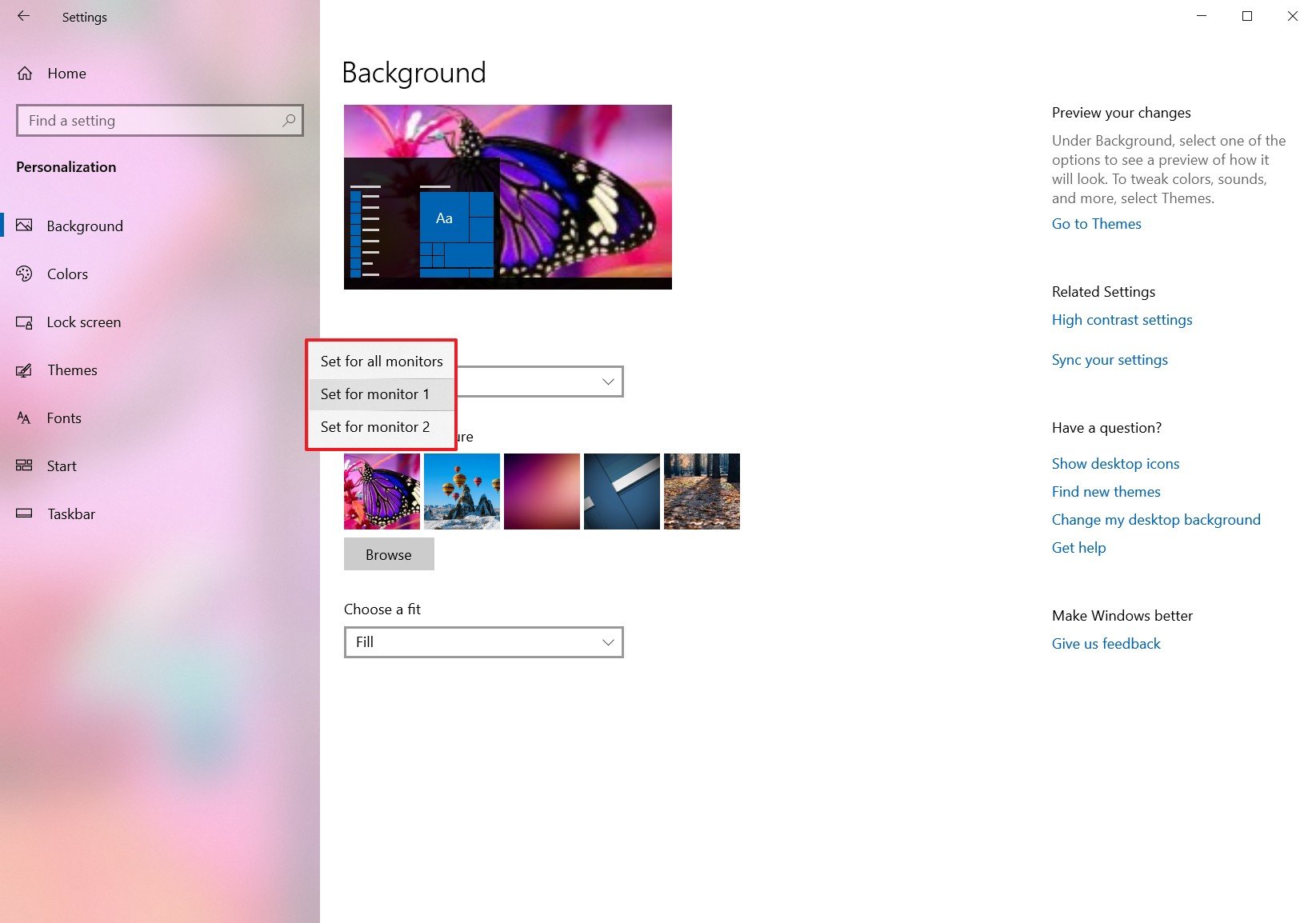
- Repeat steps No. 5, 6, and 7 to set a custom groundwork for some other monitor.
Afterward y'all consummate the steps, each monitor will display a custom wallpaper.
In addition to the instructions outlined to a higher place, here are a few boosted tips to go along in listen when setting upwards a computer with multiple monitors. For example, unless information technology'southward a laptop, you shouldn't effort to adjust the effulgence or colour using Windows 10 or some other application. Instead, you should employ the controls congenital into the monitor.
In the instance that the second monitor isn't getting detected, check its connections, and use the Observe button in the Settings app. If you're withal having issues, you can use this guide to troubleshoot and set common problems.
Finally, when using ane or multiple monitors, yous may come up across a black screen, which it's typically a video driver related problem. If y'all're non certain how to fix this issue, yous can follow these steps to resolve the problem.
Mauro Huculak is technical author for WindowsCentral.com. His chief focus is to write comprehensive how-tos to help users get the most out of Windows 10 and its many related technologies. He has an IT background with professional certifications from Microsoft, Cisco, and CompTIA, and he's a recognized fellow member of the Microsoft MVP customs.
Source: https://www.windowscentral.com/how-connect-and-set-multiple-monitors-windows-10
Posted by: walstonlond1985.blogspot.com

0 Response to "How To Multi Screen Windows 10"
Post a Comment